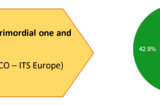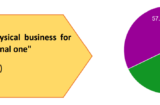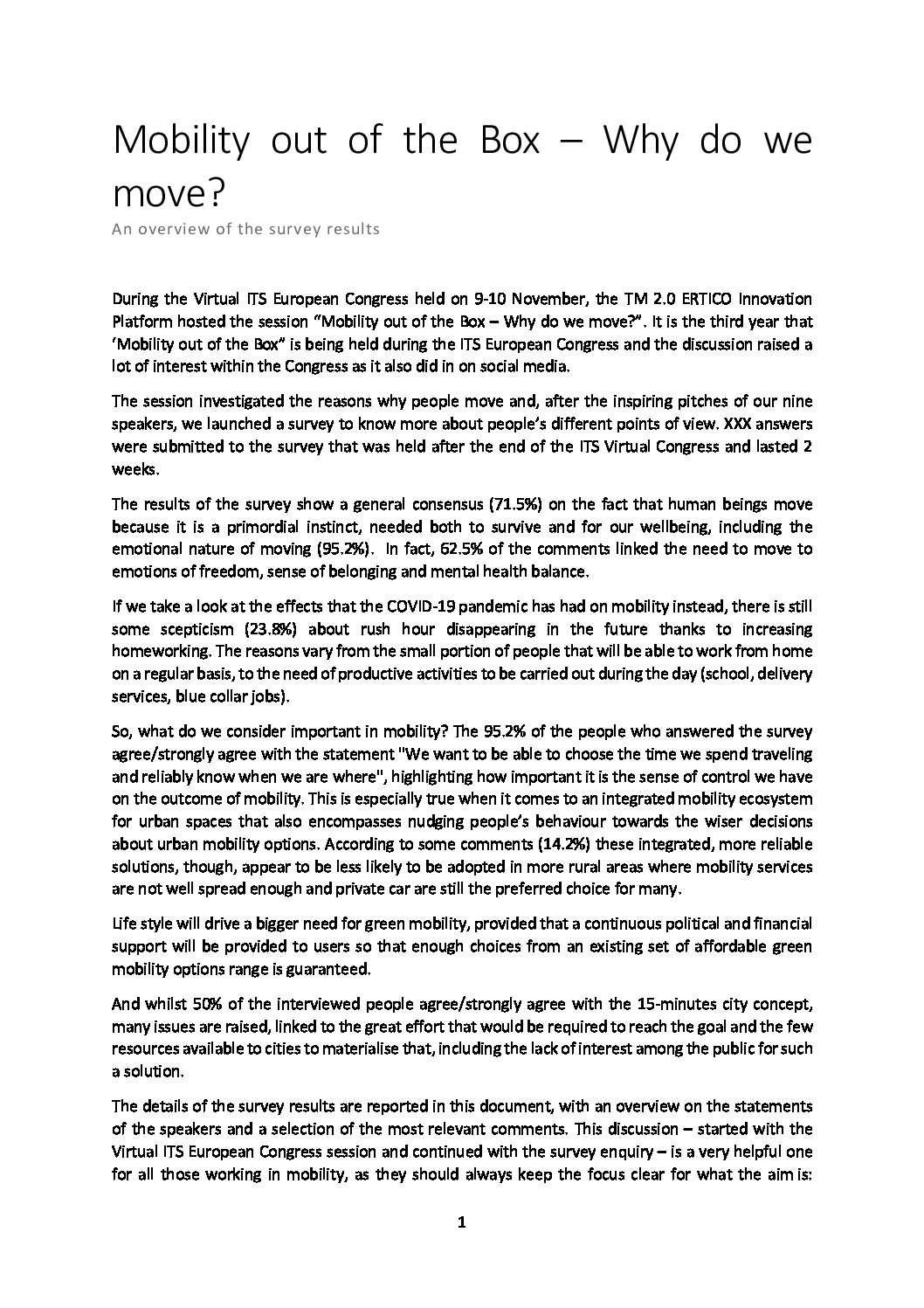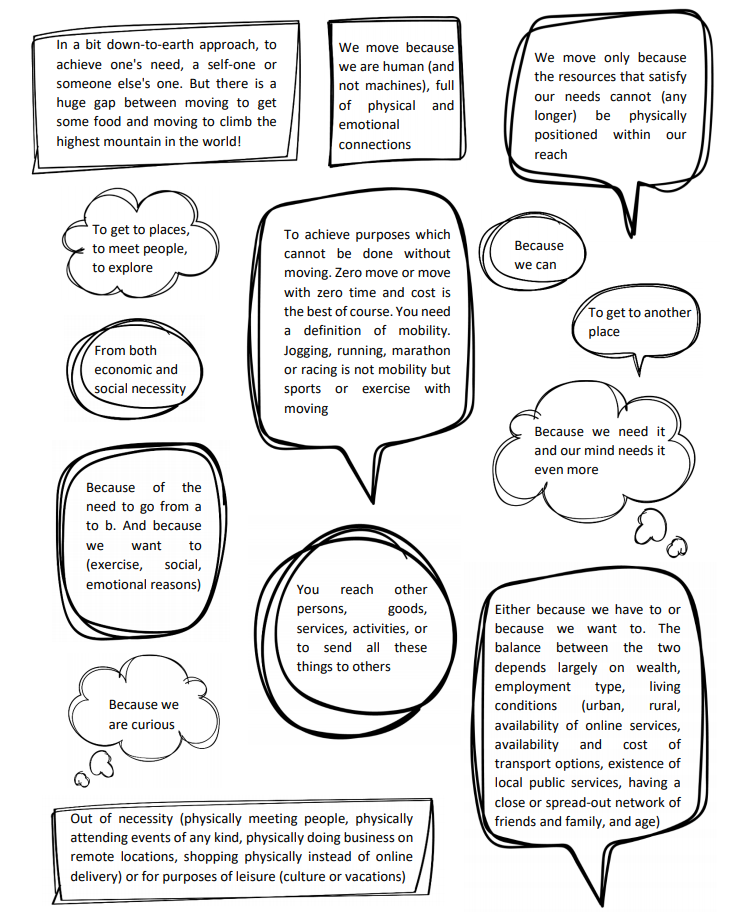- TM2.0
- TM2.0 Task Forces
- News
- Events
- Blog
- Library
- Members
- Contact Us
Mobility out of the Box – result survey
Click here to download the pdf
An overview of the survey results
During the Virtual ITS European Congress held on 9-10 November, the TM 2.0 ERTICO Innovation Platform hosted the session “Mobility out of the Box – Why do we move?”. It is the third year that ‘Mobility out of the Box” is being held during the ITS European Congress and the discussion raised a lot of interest within the Congress as it also did in on social media.
The session investigated the reasons why people move and, after the inspiring pitches of our nine speakers, we launched a survey to know more about people’s different points of view.
The results of the survey show a general consensus (71.5%) on the fact that human beings move because it is a primordial instinct, needed both to survive and for our wellbeing, including the emotional nature of moving (95.2%). In fact, 62.5% of the comments linked the need to move to emotions of freedom, sense of belonging and mental health balance.
If we take a look at the effects that the COVID-19 pandemic has had on mobility instead, there is still some scepticism (23.8%) about rush hour disappearing in the future thanks to increasing homeworking. The reasons vary from the small portion of people that will be able to work from home on a regular basis, to the need of productive activities to be carried out during the day (school, delivery services, blue collar jobs).
So, what do we consider important in mobility? The 95.2% of the people who answered the survey agree/strongly agree with the statement “We want to be able to choose the time we spend traveling and reliably know when we are where”, highlighting how important it is the sense of control we have on the outcome of mobility. This is especially true when it comes to an integrated mobility ecosystem for urban spaces that also encompasses nudging people’s behaviour towards the wiser decisions about urban mobility options. According to some comments (14.2%) these integrated, more reliable solutions, though, appear to be less likely to be adopted in more rural areas where mobility services are not well spread enough and private car are still the preferred choice for many.
Life style will drive a bigger need for green mobility, provided that a continuous political and financial support will be provided to users so that enough choices from an existing set of affordable green mobility options range is guaranteed.
And whilst 50% of the interviewed people agree/strongly agree with the 15-minutes city concept, many issues are raised, linked to the great effort that would be required to reach the goal and the few resources available to cities to materialise that, including the lack of interest among the public for such a solution.
The details of the survey results are reported in this document, with an overview on the statements of the speakers and a selection of the most relevant comments. This discussion – started with the Virtual ITS European Congress session and continued with the survey enquiry – is a very helpful one for all those working in mobility, as they should always keep the focus clear for what the aim is: working towards a better, safer and more efficient mobility. To achieve that, a deep understanding of the human need to move, including its constrictions, contingencies and desires, is paramount to provide the best possible solutions. Knowing the ‘why’ will certainly guide us to the ‘how’.
Mobility out of the Box – Why do we move?
Survey results
During the session “Mobility out of the Box – Why do we move?” held at the Virtual ITS European Congress on the 9th and 10th of November, we asked 9 speakers, in their 4-minute pitch, to provide a statement on their vision.
We then asked the audience to provide us with their feedback on those statements, including their own answer to the question “Why do we move”. The results of the survey are detailed below.
- In primordial era it should have been so.
- There are academic studies to support this contention.
- Human beings used to be nomadic, we have settled down.
- This is only a metaphor, and the assertion behind it is questionable.
- Even in pre-historic age, the need for mobility existed – hunt, find shelter, etc.
- As Siemens Mobility’s advertisement puts it, we have the urge to move – it is our nature!
- At least that is what science tells us, see https://en.wikipedia.org/wiki/Marchetti%27s_constant
- Totally agree that we need to move but less and less by the schedules like we used to move. The freedom of mobility raises all the time.
- This is true when you are moving/exercising. While sitting the step will get bigger to start moving. So depending on the starting point.
- Depends on the person- some are adventurous, sociable, want to go out and visit places/people, others are happier to stay at home (also depends on age, disability, whether living alone or with a family, quality of home life, ease and cost of travel options to other places).
- Not everyone works in an office. There will still be physical workplaces, and places of
education. And families need time together, so travel times can’t be endlessly flexible. - No they don’t but not because of parking, but flexible working hours.
- Schools continue to operate, there are jobs that cannot be switched to teleworking. So yes, I think there will always be a rush hour traffic but with less intensity.
- Those who can remotely work are often in a minority: others have to physically travel in order to serve us: professional drivers, store and warehouse staff, builders, factory workers, farmers. However, rush hours may occur at different times with a more 24-hour economy.
- It depends on region or transport capacity.
- Not everyone will work remote. Peaks will be lower but will still be there.
- Rush hours will still exist, maybe at a lower level (less peak traffic, different hours, etc.).
- Only about 20% of the workforce has the luxury to be able to work from home. The other 80%
are often bound to fixed schedules and don’t even have the choice. Company and school schedules need to become more flexible to overcome the rush hour, also see https://mobilityas-a-service.blog/demand-management/. - So long as there are roads, they will be filled to capacity at least sometimes and somewhere.
- Remote working has to be completely stable for it to form part of a silver bullet to reduce congestion/rush hour traffic.
- Keeping still is not living :)
- Nothing to do with cities.
- Depends again on the individual. Some have stimulating hobbies at home, others love to go out.
- It depends on the degree of the movement.
- I think exercise and wellbeing can enhance each other.
- Maybe “degenerate” is too strong!
- I agree that movement it essential for wellbeing but this is not what’s causing most problems. Movement for the sake of it would likely not happen during rush hours.
- Surely the need for movement depends largely on the size of the community, not its type – and I don’t regard its impact on wellbeing as universally positive.
- Believing you control your own life is closely linked with improved mental wellbeing.
- Many already do so e.g. when choosing where to live in relation to their work, schools, shops, leisure facilities. But cost is also a factor: many travel more than they want to because they cannot afford housing close to their work, e.g. low paid manual workers in a big city.
- I think people want travel to be more comfortable. Having a choice is a part of this.
- Reliability is important, and often underestimated.
- No doubt about that. This is the reason why relying on others (public transport, car pools, especially with change of modes) causes stress and gets often avoided by using the own vehicles, which we have perceived full control of.
- Very true, since travelling often requires us to be idle and we seek ways out of this idleness.
- Because of the ideas shown in the video, is it true to say that machines will never be able to properly imitate us or take us out of the mobility equation?
- Sometimes mode and route depend on personal preferences and are not necessarily the most efficient, fastest or cheapest.
- Sometimes I want to run without purpose.
- By moving, people are able to clear their heads.
- Being able to move means freedom.
- Moving is only emotional for those people that choose to make it emotional, that have a need to do so.
- It is our natural instinct to want to meet with one another.
- The concept is very attractive. But in most parts of the world it will require a big change in what types of housing people regard as desirable.
- 15 min city concept – a vision to put in every urban plans.
- The trend over past decades has been the opposite, local facilities near people’s homes closing down because they cannot compete with the economies of scale of big retail or leisure facilities. The only way to reverse this is to ban (or severely restrict or heavily tax) out of town shopping centres, supermarkets, and car use.
- In this era everyone needs new stimuli all the time. Going to the same place all the time will not work.
- The 15-minute city concept is too utopic. But it is an interesting one, and we can help it to emerge.
- I love the vision, which is not new. I just fear that gentrification keeps generating a different reality.
- The sacrifices needed to reach such a pastoral view would be horrendous. I expect to see the same picture as today, only even more crowded, hurried and technologically advanced.
- This is much more of a vision than a concrete possibility, a vision that would surely be ideal for the future.
- A truly integrated ecosystem mobility model will enable us to choose a more sustainable and efficient mobility!
- For essential and local trips, yes, agree. For leisure or long distance trips, probably not because these are usually one-off trips (outside services like MaaS) and depend more on individual preferences rather than needs.
- Not by integrated mobility but ICT technologies including virtual reality.
- I think this works for some people. Other people are internally motivated.
- There is a need to optimise mobility networks, and for that we need to have different means of transportation, each one with its relevant operational domain so that each one can supplement the other modes.
- I assume that this will be very region-specific. In rural areas the privately owned car will still be the one mode of transport for quite some years I fear.
- Likely, but only because mobility actors will find such an ecosystem easier to manage and develop. Integration of everything is not a universal truth in itself.
- We underestimate how much gamification and rewards can achieve in this area.
- This can teach us which direction to go to.
- If I would know that I will get stuck in traffic and have the freedom to change, I would likely do so.
- “Nudging” is a euphemism for exertion of power, for rules and penalties – these don’t inspire, they coerce. Such ways of governance are acceptable, of course, but we’d do well to call them by their real names
- Life style has a lot to do with motivation to do something.
- Could be that it is only me but I most often move because I have to get somewhere and not for the sake of movement. And I can only choose from an existing set of mobility options.
Lifestyle might just change which options I can afford or prefer but for green mobility there need to be green options. - Green mobility is and will be driven by political and financial forces, and only a minority will voluntarily adopt it as part of their lifestyle.
Please provide your answer to the question, and topic of the session, “Why do we move?”
Why do people move? – The word cloud
 ERTICO Partnership Activities We use cookies on our
ERTICO Partnership Activities We use cookies on our - Events
























